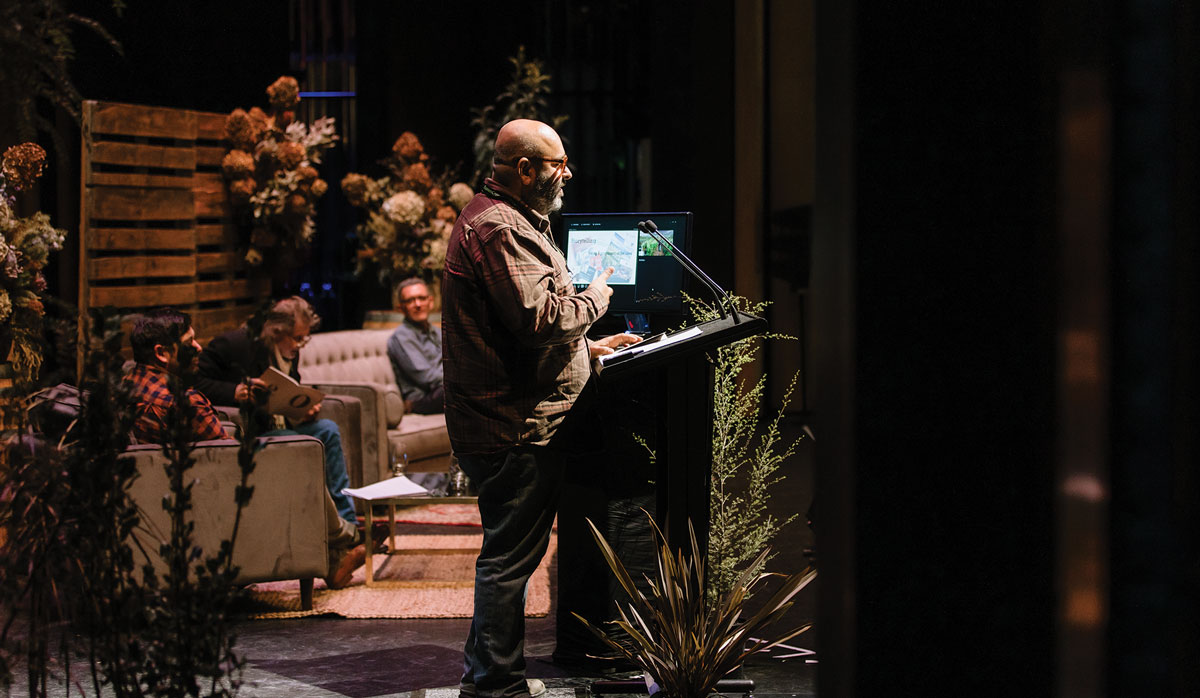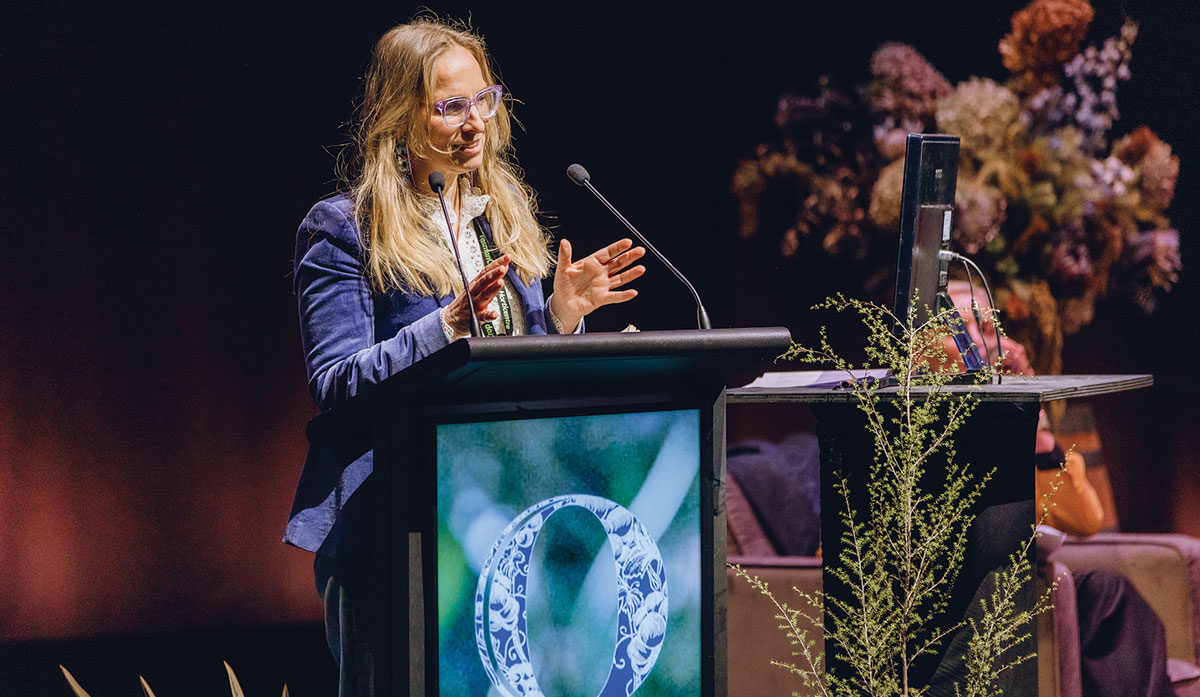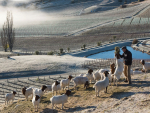Emma Jenkins' MW Musings: Do we need wine?
OPINION: At the recent Organic and Biodynamic Winegrowing Conference, the Porto Protocol’s Marta Mendonça said, “Grapes are not the thirstiest of crops, but they are a luxury crop”.
The Organic & Biodynamic Winegrowing Conference brought together local and international experts to explore themes of soil, water, biodiversity and regenerative systems. Emma Jenkins MW shares some of the science, insights and passion from June's three-day gathering in Blenheim.
Structured around the framework of ki raro, ki runga, ki te rangi - underneath the earth, above the ground, into the sky - the fifth biennial Organic & Biodynamic Winegrowing Conference deftly blended technical insight, philosophical reflection and practical experience.
It opened with a heartfelt address from Organic Winegrowing New Zealand Chair Clive Dougall, who described New Zealand's pending gene tech legislation as an "existential threat" to organic producers. That concern was echoed by Professor Jack Heinemann from the University of Canterbury, who delineated the risks of the proposed regulatory changes for winegrowers and the entire organic sector.
Climate resilience was an ever-present theme, but speakers also warned against over-prioritising carbon at the expense of water and biodiversity. "Soil is the basis of life - a statement that cannot be improved upon", Dr Peter Espie said as he unpacked the latest thinking on the microbiome - "the future of fine wine".
Technical highlights included Dr Charles Merfield’s fascinating critique of tillage and weed management, which had many rethinking their own approaches. Dr Sara Loeffen outlined DNA-based tools for measuring earthworm density, Dr Mark Kraznow offered a ‘how to’ for resilient vines, and freshwater advocate Dr Mike Joy delivered a wakeup call on the state of New Zealand’s waterways.
On the practical front, Jim Bowskill shared the results of his organic viticulture benchmarking research, and Lincoln University’s Olaf Schelezki outlined a report on challenges and enablers for Central Otago’s prospects of being 50% organic by 2030. Nick Gill’s explanation of the Regenerative Viticulture Foundation’s One Block Challenge drew interest from many growers curious about regenerative experimentation, and Marta Mendonça, Head Manager at the Porto Protocol, a global climate action network for the wine industry, kickstarted a packaging discussion.
From a global perspective, American speakers Joseph Brinkley (Bonterra) and Rajat Parr (Phelan Farm) offered practical and philosophical reflections on maintaining integrity in large and small scale organic farming. Joseph outlined how organic certification can underpin strong brand identity, underscored by Raj’s conviction that younger consumers demand traceability, soul and story. Katia Nussbaum (Montalcino, Italy) spoke eloquently of San Polino’s 40-year pathway from conventional to the forefront of ‘vitiforestry’, as it sought to expand what is understood about the vineyard’s mycelial networks and relationship to the surrounding forest. Katia also gave an extraordinary closing discussion on the concepts of mycelial networks and what vine consciousness might mean for us all.
Artificial intelligence storytelling, urban community farms, certification considerations and hybrid grape varieties, among other topics, broadened the conversation, while evening events, including an impressive Matariki feast, offered further opportunity for connection, celebration and collaboration.
What emerged over three days was clear: there’s no one-size-fits-all path, but the direction is shared. As Katia said: “There’s a hope for the future, but it lives under our feet, and we have got to respect it.”
Growing Resilience
Leading viticulturist and agroecologist Dr Mary Retallack urged winegrowers to challenge conventional thinking and embrace a diversity of ideas, cultivating a “polyculture of thought”. The founder of Retallack Viticulture and Ecology, and of Australia’s EcoVineyards programme (ecovineyards.com.au), shared her passion for building vineyard resilience through functional biodiversity and native insectaries. Her message was clear: it’s time to fundamentally shift our approach to vineyard ecosystems, moving from intervention-based monocultures to dynamic, living systems grounded in agroecology.
The food system is considered the primary driver of biodiversity loss, and some research claims we have less than a decade to restore ecosystems. In vineyards, that means covering the soil and promoting active root growth, feeding soil microbial life, establishing diverse groundcovers (grasses and forbs – herbaceous flowering plants), moving away from less stable monocultures to polycultures, and favouring native, perennial plants over exotic or annual species. “Scruffy is often functional,” said Mary, advocating for “ripping off band aids or short-term solutions to break the cycles of intervention”, in favour of long-term ecological thinking.
In 2022 Mary secured AU$2.2 million in funding from Wine Australia for EcoVineyards, a national programme that now spans 76 demonstration sites across 14 Australian wine regions, and has already helped drive a 25% increase in biodiversity, 35% increase in the use of ground covers, and improvements in soil remediation practices. She outlined her approach to agroecology as a diverse type of thinking, with ecological land management practices that helped create a framework of step changes tailored to complement any vineyard management style – conventional, organic, biodynamic or regenerative – and then scaled up as growers gained confidence.
Rather than seeking rigid prescriptions, growers are encouraged to ask, “does this practice bring me closer to, or further from, the goal of working in harmony with nature?” Covering both philosophical grounding and practical instruction, Mary made the distinction between ‘dirt’ (geology without biology) and living soil, and explained soil health indicators, what to focus on when selecting groundcovers, and the value of having a variety of plant and animal life in the vineyard. She emphasised the importance of nature corridors, with a minimum of 30% original vegetation cover required to stem species loss.
Mary brought both rigour and charm to functional biodiversity and native insectaries, reminding the audience that a group of ladybirds is a ‘loveliness’. Predatory arthropods (insects, spiders, mites), microbats (of which New Zealand has two species), and insectivorous birds were championed as nature’s biological control agents, offering virtually free pest suppression in return for a happy home. She outlined how to attract them with insectary plantings, planting species for overlapping food sources for year-round supply of nectar, pollen, shelter and alternative prey, and favouring low maintenance perennial or self-regenerating natives. She also recommended ditching traditional end-row roses in favour of local flora.
 |
|---|
|
Rajat Parr. Photo Credit: Lisa Duncan |
Backed by Australian case studies, along with an example of native plant trials in a Hawke’s Bay vineyard, Mary’s work is a compelling story of practical ecological knowledge helping to future-proof vineyards. She invited attendees to rethink sustainability as a starting rather than end point, and to embrace regenerative and ecological practices instead.
Why Purpose Matters
“The most important thing in life is intention,” said renowned United States sommelier-turned winegrower Rajat Parr. Intention and honesty go hand-in-hand in organic winegrowing and are preeminent in a world where the younger generation of drinkers increasingly demand both, he told conference attendees, explaining why purpose matters more than ever in wine.
When he started as a sommelier, Rajat had never heard the word organic. But by the late 90s, conversations around natural wine sparked by Beaujolais’ pioneering ‘Gang of Four’ began to change the landscape. A conversation with Jean-Louis Chave reframed the idea from trend to tradition for Rajat. When asked what organics meant to him, Jean-Louis simply replied, “After 14 generations of making wine the same way, we don’t know any other way.”
When Rajat eventually transitioned from restaurant floor to vineyard, he knew his wines had to be grown organically. The pathway began with Domaine de la Côte, Sandhi, and Evening Land (made with winemaker Saschi Moorman), leading to his own vineyard, Phelan Farm, in Cambria (San Luis Obispo AVA), an idyllic spot within view of the sea. “Learning how to understand nature is probably the hardest thing I have ever done,” Rajat admitted. In a forested valley, the vineyard has come with lots of challenges – thistles, frost, disease, tiny crops – but his passion is undimmed. Sap analysis, experimental ayurvedic tonics, sheep, and livestock guardian dogs are now all in the mix, with the economics aided by his consultancy work through his négoce label and private backers.
In California, where organic vineyards make up only 4% of plantings, Rajat acknowledges that consumers often fail to grasp the farming impact, but he’s observed a stark generational shift occurring. “Boomers typically don’t care about organics, but Gen Z want soulful, energetic wines, and they’re incredibly good at detecting ‘BS’.” He believes they want authentic stories of place, backed by real people. “Those who don’t get this will struggle. Real terroir is not only the land; it is also you.”
Rajat highlighted three producers epitomising intentional farming:
At Phelan Farm, Rajat is living his philosophy. “You have to trust your land,” he concluded. “Farm the best grapes, make the wine simply, age as long as you can, bottle without filtering or fining. Translate what’s living in the soil into what’s in the bottle.”
Waking Up To Water Woes
The use, management, perception, and protection of water were a key focus at the conference, with Victoria University’s Dr Mike Joy compellingly frank about what he called New Zealand’s “Faustian bargain” with freshwater. Despite the country’s carefully cultivated clean, green image, 45% of its lakes are “officially polluted”, including nearly all lowland lakes, and 85% of its waterways exceed nitrogen guidelines, with many of them un-swimmable. Mike presented a bleak picture of ongoing degradation, abuse and negligence, much of it driven at the legislative level, with politicians happy to ignore the science.
He highlighted the costs borne by taxpayers for environmental cleanup – “we subsidise harm, and socialise the costs, accepting the right to pollute” – and the looming risk of reputational damage, none of which are factored into the perceived returns of the agricultural sector. We know the solutions to our freshwater problems but have yet to show the collective will to implement them, he said.
Ian Trousdell, of Flowform International, introduced the concept of ‘quantum coherent water’, speaking eloquently about how nature moves water in deliberate patterns – vortices, laminar, rhythmic and chaotic flows – that together sustain pH-balanced, super-oxygenated, energy-rich water. He called for a shift in perspective, suggesting we should begin to view all water as a single interconnected entity, as we do with air. This mindset, he argued, opens the door to understanding how quantum physics principles relate to water, particularly in terms of energy flow states.
Ian explained that everything alive depends on water, be it via blood, sap, or any cellular fluid, outlining a constant interchange of particles of energy that make up physical things (quanta) and light waves. “When that occurs at a high frequency with low resistance, water can receive energy and replenish its particles smoothly and efficiently - you have high coherence.” He showed examples of Flowform’s biomimetic systems – cascading, interlinked shallow bowls designed to move water in a pulsing figure-eight motion – mimicking natural movement. These, Ian noted, may have practical applications in wine production, such as improving ferment quality.
Charlotte Tomlinson, environmental scientist at Marlborough District Council, gave an overview of how Marlborough’s river systems are managed. With hotter, drier growing seasons expected, she said storage will be key, and is likely shift from a backup to a primary source of water in the future.
The final speaker was Marta Mendonça, who spoke with conviction about the Porto Protocol and wine’s often-overlooked water footprint. She urged the industry to bring water to the forefront of sustainability thinking, “because water is sacred, it’s alive. Water is life… it is not just a tool.” Marta argued that water use in viticulture deserves the same reverence as terroir: “It nourishes our vines, it shapes our yield and quality. It is the silent ingredient in every bottle.” While carbon footprints are now widely understood, water footprints remain largely unexamined, shaped by outdated, highly politicised policies that have long favoured industrial agriculture and encouraged wasteful use-it-or-lose-it approaches.
She warned of the industry’s “carbon tunnel-vision”, suggesting that it may not yet have the answers for water use simply because “we are not yet even asking the questions”. Although the International Organisation of Vine and Wine is currently reviewing global measuring frameworks, Marta stressed that we cannot wait for perfect data before taking action. Instead, she advised we must recognise the complexity of green (rain/groundwater), blue (irrigation) and grey (recycled or ‘waste’) waters, and consider each in terms of source, timing and location of use, and the myriad indirect water uses across wine’s production chain.
She acknowledged programmes like Sustainable Winegrowing New Zealand that already track water use, and highlighted the impact that even simple changes, such as reducing hose diameter reduction or UV light disinfecting, can have, but added that this is an “incomplete scenario”. Instead, “understanding systems is the goal”, emphasising that true progress requires a mindset shift where “water is respected, not just measured”.
 |
|---|
|
Marta Mendonça. Photo Credit: Lisa Duncan |
The Porto Protocol
The Porto Protocol is a global action network and knowledge hub dedicated to climate change action within the wine industry. Launched in 2018 at Portugal’s Climate Change Leadership Conference, it now has more than 250 members in more than 25 countries, who commit to measurable climate action and collaboration via an online resource hub. The Protocol focuses on four areas: packaging, water, ecosystems and change. It turns shared knowledge into collective action through case studies, tools and events, helping wineries and related businesses adopt practices such as water conservation strategies, biodiversity protection, renewable energy initiatives, and circular economy models. Plans include developing a comprehensive governmental White Paper aimed at bringing together its insights and solutions to accelerate progress. New Zealand currently has four winery members, including Central Otago’s Coal Pit, which is a Leading Member.
The Porto Protocol’s ‘Unpacking Wine Guide’ is available for download at nzwine.com. nzwine.com/members/sustainability/guides/climate-change/

The end of the year is fast approaching, so here are some thoughts on a few of the significant developments…

OPINION: When I moved to Marlborough two decades ago, I found countless lines of tidy vines, neatly mowed and carefully…
The large 2025 harvest will exacerbate the wine industry's "lingering" supply from recent vintages, New Zealand Winegrowers Chief Executive Philip…
If you find a new consumer in a developed wine market, you are taking them from someone else, says Blank…
OPINION: Sauvignon Blanc was famously introduced to New Zealand by Ross Spence of Matua Valley, and then serendipitously planted in…